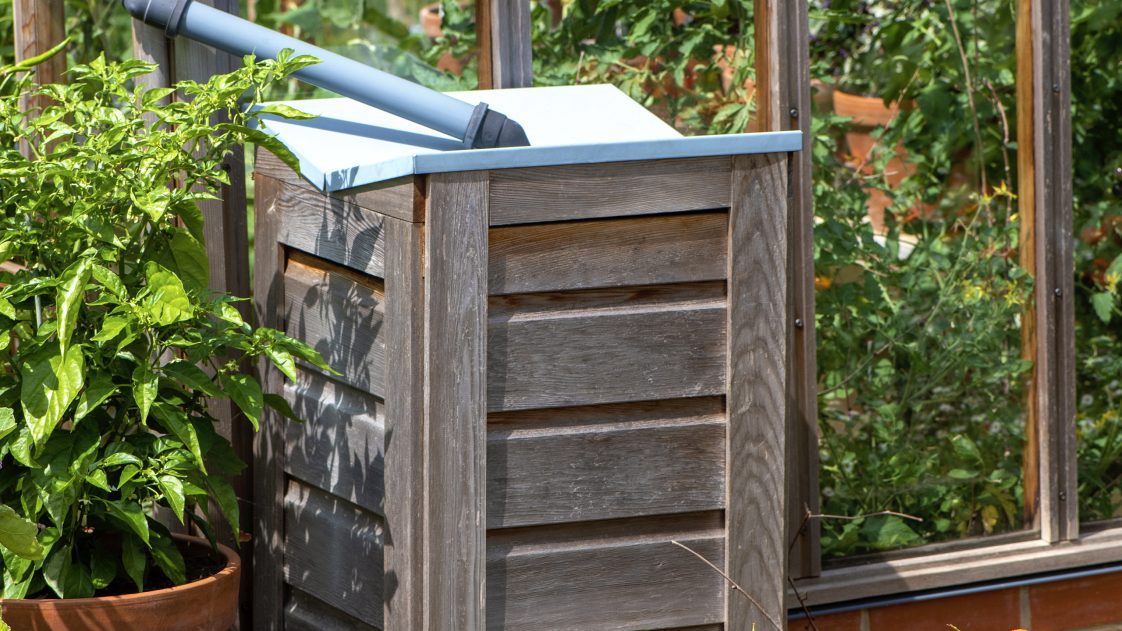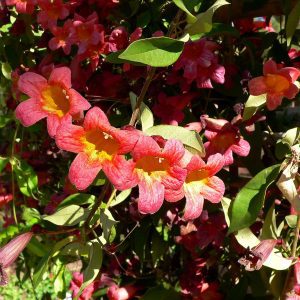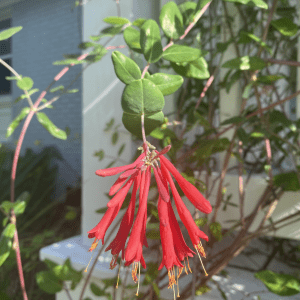Fish & Water

Painting Your Barrel

Figure 37. Paint cans open and ready to use
Many options exist to get creative with your rain barrel. You may decide to paint your barrel, grow plants around the barrel, or even use a trellis to conceal it.
Cleaning and priming: We recommend cleaning and priming your barrel before painting. You also can sand the entire barrel with a 220 grit or finer sandpaper before cleaning. Be sure to use sandpaper that does not leave scratches. This extra step is well worth your time.
Clean the exterior surface with a 1:1 mixture of vinegar and water. Next, cover the barrel with any kind of color primer and paint, as long as the base coat is a paint that sticks to plastic. Check the label for appropriate use on plastic.
Coverage: One can of spray paint typically covers up to 25 feet. You can cover a rain barrel with one can, but two cans are recommended to create a more finished look. Darker colors require more paint. It’s also good to have leftover paint to touch up your barrel if it gets scraped later.
How to paint:

Figure 38. Painted rain barrel. (Photo credit: Kimberly Counts Morganello, Clemson)
- Paint in a well-ventilated area, ideally 50 to 85 degrees F in low humidity.
- Cover spigot and overflow valve with masking tape. Keep in mind that overflow may impact your painting design over time.
- Shake can vigorously for 2 minutes; hold 8 to 10 inches from surface.
- Spray in a sweeping motion, keeping an even distance from the barrel surface. To avoid messy edges, sweep the spray starting away from the surface of the barrel (into the air), moving to the barrel surface, and finishing into the air away from the barrel.
- Apply a thin coat and wait 30 seconds.
- Apply multiple thin coats to avoid runs and drips.
Color considerations: Consider painting your rain barrel the same color as your house to camouflage it; this may be helpful in areas with HOA restrictions. Remember, darker barrels are better for preventing algae growth.
Dry time: 15 minutes or less; handle after 1 hour
Recoat: Before 24 hours or after 7 days
Preservation recommendation: Use a car plastic preservative on your rain barrel a couple times a year to brighten, condition, and protect it for a long life.
A More Natural Way To Make Your Rain Barrel Attractive
Another option for beautifying your rain barrel is to conceal it with plants. Secure a trellis, plastic mesh, or wiring adjacent to the barrel and plant a hardy vine at the base. Allow the vine to climb up the mesh, but be careful not to let it block access to the rain barrel. Anytime a vine is planted, it is important to maintain vine growth by regular hedging to ensure that the vine does not cover more space than intended.
Native plants provide habitat for local wildlife and food for beneficial groups such as songbirds and pollinators. Non-native species usually do not provide this benefit, and they can spread rapidly while competing with native species. Gardening with native plants is an effective way to support your local ecosystem. Here are some plants to consider:
Bignonia capreolata (crossvine) is a vigorous clinging vine that climbs using tendrils. It has semi- evergreen leaves and orange-red blooms that attract hummingbirds (figure 39).
Gelsemium rankinii (swamp jessamine) is very similar to Carolina jessamine but tolerates wet conditions better (figure 40).
Gelsemium sempervirens (Carolina jessamine) is a twining vine. It grows upwards from the shoots in a helix rather than clinging form and needs a support to grow on.
Lonicera sempervirens (coral honeysuckle) is a semi- evergreen that attracts hummingbirds. It is a twining vine and needs a structure to grow on (figure 41).
- Figure 39. Crossvine, ‘Tangerine Beauty’
- Figure 40. Swamp jessamine
- Figure 41. Coral honeysuckle
For more native plant suggestions, visit the Lady Bird Johnson Wildflower Center’s Native Plant Database at www.wildflower.org/plants. Under Combination Search, select the following: State (Alabama), Habit (vine), Duration (perennial), Leaf Retention (evergreen), Light Requirement (sun and part shade), Soil Moisture (moist). You can narrow this search further by also indicating blooming time and bloom color.
Using Your Landscape To Collect Rainwater
To further benefit the environment, consider using your active rainwater harvesting in tandem with passive rainwater harvesting landscape features. Overflow from your rain barrel can be directed to a rain garden or landscaped bed. Passive rainwater harvesting can include contouring your landscape to help capture, hold, and infiltrate water to harvest more rainwater on your landscape. Be sure that water infiltrates soil before reshaping the contour to avoid creating issues associated with standing water.
Rain gardens are vegetated depressions that intercept runoff from impervious surfaces and allow that runoff to infiltrate into the soil. In a rain garden, physical, chemical, and biological actions take place to remove pollutants from that runoff. For instance, sediment settles out, plants uptake nutrients, and microbes remove bacteria and metals. For information on building a rain garden, read “How to Install Your Own Rain Garden” in the Alabama Low Impact Development Handbook.16
Other Ways To Conserve Water
- Drip irrigation allows water to disperse directly to the plant and minimizes water evaporation (water loss).
- Getting your soil tested will help you learn which plants are suitable for a certain area of your yard. Agents at your county Extension office can offer advice (www.aces.edu/counties).
- Remember, plants require specific habitats and soil types. Using native plants can reduce the need for excess water use while providing valuable habitat. Putting the right plant in the right place helps to prevent overwatering.
- Utilize the tallest recommended mowing height to reduce irrigation needs; this also will lead to strong, deep root systems. In general, remove no more than one-third of the height of your grass blade.
- Water lawns only when they show signs of stress, like when you walk across your grass and your footprint stays. Most lawns and plants need no more than 1 to 1 1⁄4 inch of rain per week.
- Install a rain gauge to determine when and how much to irrigate.
- Group together plants of similar water needs.
- Use soil amendments such as compost to allow the soil to hold more moisture and extend the time between watering. Similarly, mulch landscaped beds to lessen soil evaporation and extend time between watering.

 Laura Bell, Project Coordinator; Eve Brantley, Extension Resources Specialist and Professor; Naomi Pitts, Watershed Program Assistant; and Caitlin Sweeney, Watershed Program Assistant, all with Alabama Extension Water Program, Auburn University
Laura Bell, Project Coordinator; Eve Brantley, Extension Resources Specialist and Professor; Naomi Pitts, Watershed Program Assistant; and Caitlin Sweeney, Watershed Program Assistant, all with Alabama Extension Water Program, Auburn University
Special thanks to Rhonda Britton, Regional Extension Agent, for her contributions to this handbook.
New August 2021, A Homeowner’s Guide to Rainwater Harvesting in Alabama, ANR-2794




